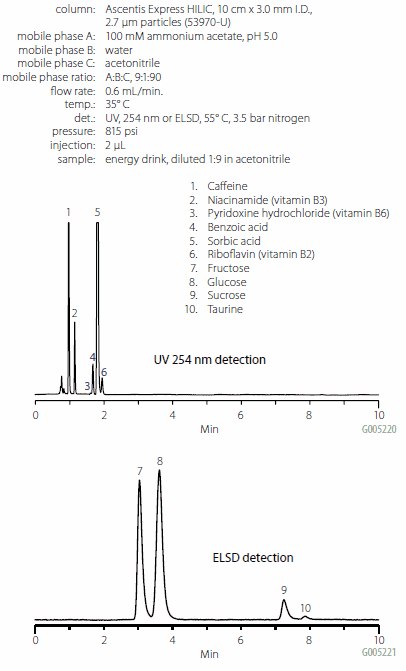Caffeinated Energy Drink Analysis by HPLC
Already very popular for separations in the pharmaceutical industry, Ascentis® Express has applicability to separations in many other industries, such as food and beverage. This page shows an example of how Ascentis® Express provides the high speed and high efficiency of sub-2 μM particles, but at half the backpressure. This lower pressure means that Ascentis® Express can be run on all HPLC systems, including conventional as well as UHPLC systems.
HPLC and Food Analysis: Caffeinated Energy Drinks
Caffeinated energy drinks contain a variety of ingredients that usually includes a sweetener (sugars, synthetic sugar substitutes, zero-calorie natural sweeteners), vitamin B supplements, and, of course, caffeine. They may also include amino acids, organic acids, and various plant extracts. The sample complexity makes it important to use highly-efficient, highly-selective phases and columns that are compatible with different detection systems to maximize the information from HPLC experiments. Ascentis® Express Fused-Core® columns meet these requirements.
Efficient, Robust Columns for Long Lifetime, Even with Real Samples
Our applications group received a request from a customer to help them transfer their 1980’s-era HPLC method onto new technology Ascentis® Express columns, to take advantage of the speed and sensitivity benefits the columns offer. The sample was a diet cola beverage. After we completed this work, we applied the approach to today’s popular energy drinks, first looking at methods to resolve the vitamin B group. These compounds are widely used as additives, though drinks vary as to which ones are present. We also wanted to be sure the method was applicable to caffeine, sugar, and organic acids, since these are also common ingredients. We chose ROCKSTAR® Energy Drink for our initial evaluation. Although by no means a comprehensive study, we were able to resolve the major components of the drink, leveraging detection method (UV and ELSD) and phase chemistry to alter elution pattern and sensitivity.
Using Phase Chemistry to Alter Retention and Elution Patterns
During our method development we explored different Ascentis® Express phase chemistries, in particular the HILIC and RPAmide. These phases were chosen because of their enhanced performance toward polar compounds compared to C18. HILIC (hydrophilic interaction chromatography) is complementary to reversed-phase separations, providing different selectivity for polar compounds and using high organic mobile phases. Important benefits of HILIC are retention of highly polar analytes (like metabolites) and increased MS sensitivity.
We also chose 3 mm I.D. columns to improve sensitivity by reducing peak volume over 4.6 mm I.D. columns. All separations were run on conventional HPLC systems; unlike columns packed with sub-2 μM particles, Ascentis® Express does not require ultra-high pressure instruments to achieve the rapid, efficient separations.
The results on the Ascentis® Express HILIC column are found in Figure 1. Here, UV and ELSD detection was used to detect different types of compounds; ELSD allowed us to see the non- UV absorbing sugars. The HILIC conditions yielded extremely rapid analysis (under 2 minutes) and MS-friendly mobile phase. The low backpressure of HILIC mobile phases also permits high flow rates for fast analysis.

Figure 1.Energy Drink on Ascentis® Express HILIC 53970-U
Figure 2 shows the results on the Ascentis® Express RP-Amide. Although technically operating by a reversed-phase mechanism and operating in the same types of mobile phases, the amide functional groups confer different selectivity than alkyl-only phases, like C8 or C18. The selectivity differences are most noticeable with polar compounds, like those in this application.

Figure 2.Energy Drink on Ascentis® Express RP-Amide 53916-U
Selectivity, Peak Order, and Trace Analysis Implications
Comparing the separations on the HILIC and RP-Amide columns, a few points are notable. Both showed good retention but different elution patterns of these very polar compounds. Of particular importance is the relative elution of caffeine. The RP-Amide column gave greater separation and caused it to elute after the lower-concentration B3 and B6 peaks. For trace analysis, it is recommended that the component in large excess elute after the components at trace levels. Using different phase chemistries is the most effective means to alter elution order. We have provided this ability by offering a wide variety of Ascentis® Express phase chemistries: C18, C8, Phenyl-Hexyl, HILIC, RP-Amide, and ES-C18 for peptides, with others currently in development.
Conclusions
This very brief example demonstrates three important features of Ascentis® Express columns as they apply to analyses in the food and beverage industry:
- they provide very rapid separations on any HPLC or UHPLC system
- the robust columns stand up to long-term use, even with “real” samples
- they are available in a variety of phase chemistries for different selectivity
These benefits can be applied to analysis in any industry. The products used in this application are listed in Featured Products. The complete list of Ascentis® Express columns can be found at sigma-aldrich.com/express
To continue reading please sign in or create an account.
Don't Have An Account?